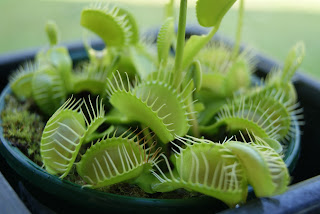Do plants eat?
B was wondering the other day, Do plants eat?
They don’t have mouths so they obviously don’t eat in the same way that animals do. But, animals eat to get nutrients for energy and growth. Plants also need to get nutrients for growth.
Plants get their food through photosynthesis. They use energy from the sun to change carbon dioxide and water into the food the plant needs to grow.
Plants get the water they need for photosynthesis and any other nutrients they require from the soil, by drawing water (containing dissolved minerals) up through the plant.
This website simply explains the different nutrients plants need and what they are for – Kids World Plant Nutrients
Celery Experiment
You can see the capillary action plants use to move water from the roots to the leaves by performing the following experiment.
You need:
Without enough light plants cannot use photosynthesis to make food. This experiment will show you the effect of blocking light from a plant’s leaves.
You need:
While talking about plants eating, my son made the observation – but plants can’t eat meat. So, we now have a new addition to our garden, a Venus Fly Trap …
When an insect crawls onto the leaves of a Venus Fly Trap they shut tight trapping the insect. The plant then releases enzymes that eat away at the insect.
Carnivorous plants grow in places where the soil has poor nutritional value and gain some of their nutrients from the insects they trap and digest. These areas are mostly wet and boggy.
Some carnivorous plants, like the Venus Fly Trap, move to catch their prey. Others, like a pitcher plant, catch insects by secreting a sticky substance that traps the insects.
You can see some pictures of different types of carnivorous plants in this National Geographic photo gallery.
Aren’t plants fascinating? What does your child wonder about plants?
They don’t have mouths so they obviously don’t eat in the same way that animals do. But, animals eat to get nutrients for energy and growth. Plants also need to get nutrients for growth.
Plants get their food through photosynthesis. They use energy from the sun to change carbon dioxide and water into the food the plant needs to grow.
Plants get the water they need for photosynthesis and any other nutrients they require from the soil, by drawing water (containing dissolved minerals) up through the plant.
This website simply explains the different nutrients plants need and what they are for – Kids World Plant Nutrients
Celery Experiment
You can see the capillary action plants use to move water from the roots to the leaves by performing the following experiment.
You need:
fresh celery sticks with leaves
a glass or vase
red food colouring
water
- Half fill the glass or vase with water.
- Mix in around 20 drops of food colouring
- Place celery in the water (leaves up!)
- Put the celery in a sunny position and watch what happens over the next few days.
Without enough light plants cannot use photosynthesis to make food. This experiment will show you the effect of blocking light from a plant’s leaves.
You need:
a plant
aluminium foil
paper clips
- Cut or tear a piece of foil to cover half of a leaf on your chosen plant.
- Put the foil on a leaf. Fold some of the foil piece around to the back of the leaf to help stop the foil from falling off. Add a paper clip to hold the foil on the leaf.
- After 4 days, remove the foil and compare the covered part to the rest of the leaf (or other leaves on the tree).
While talking about plants eating, my son made the observation – but plants can’t eat meat. So, we now have a new addition to our garden, a Venus Fly Trap …
When an insect crawls onto the leaves of a Venus Fly Trap they shut tight trapping the insect. The plant then releases enzymes that eat away at the insect.
Carnivorous plants grow in places where the soil has poor nutritional value and gain some of their nutrients from the insects they trap and digest. These areas are mostly wet and boggy.
Some carnivorous plants, like the Venus Fly Trap, move to catch their prey. Others, like a pitcher plant, catch insects by secreting a sticky substance that traps the insects.
You can see some pictures of different types of carnivorous plants in this National Geographic photo gallery.
Aren’t plants fascinating? What does your child wonder about plants?
